
Comic Book Historians
As featured on LEGO.com, Marvel.com, Slugfest, NPR, Wall Street Journal and the Today Show, host & series producer Alex Grand, author of the best seller, Understanding Superhero Comic Books (with various co-hosts Bill Field, David Armstrong, N. Scott Robinson, Ph.D., Jim Thompson) and guests engage in a Journalistic Comic Book Historical discussion between professionals, historians and scholars in determining what happened and when in comics, from strips and pulps to the platinum age comic book, through golden, silver, bronze and then toward modern
Support us at https://www.patreon.com/comicbookhistorians.
Read Alex Grand's Understanding Superhero Comic Books published by McFarland & Company here at: https://a.co/d/2PlsODN
Series directed, produced & edited by Alex Grand
All episodes ©Comic Book Historians LLC.
Comic Book Historians
All Stars 1: Dan Parsons, Larry Houston, Athena Finger, Chris Burnham, Ron Lim, and Ger Appeldoorn with Alex Grand & Bill Field
Live from SDCC 2018 your favorite Comic Book Historians, Alex Grand and Bill Field walk around the Convention Floor in the first of a 2 parter discussing Comic Book History with Star Wars and ERB Illustrator, Dan Parsons, Larry Houston the creator of the 90s X-Men TV Show, Athena Finger the granddaughter of the co-creator of Batman, Chris Burnham from Batman Incorporated, Ron Lim from the Infinity Gauntlet, and Ger Appeldoorn from Behaving Madly. Edited & Produced by Alex Grand. X-Men ©Marvel, Batman ©DC Comics, Star Wars ©Disney, Robot Coupe - Lost European - Standard License. Support us at https://www.patreon.com/comicbookhistorians
Podcast and Audio ©℗ 2019 Comic Book Historians
Live from SDCC 2018 your favorite Comic Book Historians, Alex Grand and Bill Field walk around the Convention Floor in the first of a 2 parter discussing Comic Book History with Star Wars and ERB Illustrator, Dan Parsons, Larry Houston the creator of the 90s X-Men TV Show, Athena Finger the granddaughter of the co-creator of Batman, Chris Burnham from Batman Incorporated, Ron Lim from the Infinity Gauntlet, and Ger Appeldoorn from Behaving Madly. X-Men ©Marvel, Batman ©DC Comics, Star Wars ©Disney, Robot Coupe - Lost European - Standard License. Support us at https://www.patreon.com/comicbookhistorians
Podcast and Audio ©℗ 2019 Comic Book Historians
Dan Parsons Interview found at 00:36 of CBH podcast episode above:
Bill Field: Here we are with one of our favorites, that’s Dan Parsons. Dan’s known for his long career at DC as well as his wonderful career doing Star Wars Comics for the last millennia. Dan, how is it going buddy?
Dan: It’s going pretty good. I finally made it through the crowds and got to my table.
Bill: Fantastic. We’re joined of course by my cohort in crime, Alex Grand. Alex, do you have a few things you want to ask Dan?
Alex Grand: Dan, I’ve been a big fan for a while and I remember we met last year. I want to talk a little bit about your Star Wars career. You’ve done a lot of pages, you’ve done over 150 issues you said. Tell me how you got into Star Wars.
Dan: I was here back in 2002 when I was promoting my self-published book, Savage Planet.
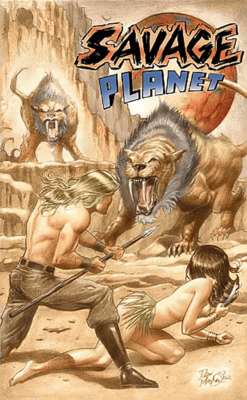
Dan: It happened that Jan Duursema was sitting down the way from me, and she had recently lost her anchor on the book. She came down and looked at my work and could see that it was highly influenced by Al Williamson, who was one of the very first Star Wars artists that there are, and so she had me do a sample basically.
Dan: She contacted the Dark Horse people and had me try off for it and I got the job. That was back in 2002 like I said. I worked on the Star Wars books almost every Star Wars title they had over there. Then finally finished up when they lost the license back in 2014.

Alex: You were talking about Al Williamson. What was some of the favorite Al Williamson comics that you’ve read?
Dan: I liked his earlier stuff to some extent, like Weird Science Fantasy. Other stuff maybe when Frazetta was working with him. That was highly influential to me and even now going back I look at his style and it looks really close to mine. I even like some of the later stuff too, like when King Features relaunched Flash Gordon. He was pencil and inking that stuff and I think it’s great.
Dan: Of course his stuff was homage to Alex Raymond. I had actually been even into Alex Raymond before I was into Al Williamson, so it all became like a big circle and basically we’re all just carrying the torch for Alex Raymond.
Alex: That’s beautiful, so Alex Raymond’s Flash Gordon, do you feel like there is an artistic influence to the Al Williamson’s Star Wars and into the Star Wars work that you’ve done?
Dan: For sure. There’s no doubt about it. As a matter of fact, even George Lucas says that Star Wars to a great extent was a homage to Flash Gordon. For Al Williamson to work on Star Wars and then me to work on Star Wars for so long, it just has a logical training that’s been going since the 30s.
Alex: You’ve done inking and penciling. You can basically do it all, and you’ve told me that you’ve been influenced by Wally Wood as well with some of your inking. Can you explain some of that?
Dan: Yeah, Wally Wood I love his brushwork, his use of blacks. I particularly like him over Gill Kane in the late 60s. They worked together quite a bit for DC. Even some of his obscure stuff like this captain action toy comic, is one of my very favorites.

Dan: I have all those and I think they made a great team. But on his own also, I think Wally Wood had a great style.
Dan: Some of his figure work was a little stiff for me as a penciler. But I think just his use of black and white is probably in the top of all comic book creators throughout history really.
Alex: Have you ever gone over pencil pages of all the pages from all the artists and tried to ink them yourself?
Dan: No, I really haven’t. When I was a kid, they had that Marvel try out book, I don’t know if you remember that. I did ink a couple of John Romita pages. Other than that, no. I’d always just pencil or make my own stuff pretty much until Jan came to me and we talked about Williamson and Frazetta and the possibility of me inking her on the Star Wars stuff.
Alex: I know that you can illustrate pencil ink, but you can also cartoon. You’ve done some nice Archie type cartooning before. Who are some of your influences there?
Dan: As far as cartooning goes, I adapted to that because I was never really inspired by the cartoon art. I was always more realistic like Gill Kane, Alex Raymond, that type of thing. But I do have a degree in fine art and I have been able to adapt my style to whatever is needed. In addition to doing the Archie thing you mentioned, more recently I did the Avatar, the last air bender book, which took a little bit of a learning curve for me to learn to style.
Dan: But it’s all a matter of style and once you study something, you can understand the style. It’s just that personally, I tended to go for more of the realistic, physical, the anatomy type artist.
Alex: I know that you and I have spoken about Marie Severin before. She would just cartoon whatever style she was working on. Is that jarring to try to do that?
Dan: It takes somewhat of recalibration but I think that you can work outside of your own personal style or what you think you really love. It’s just a matter of getting somewhere where you understand that. I think with her in particular, I like her inking most of all also for that.
Bill: I’d like to close out by talking to you about something that I know is … someone that was a real hero to you and you’ve used quite a few of his characters and drawn Steve Ditko’s style. I was curious if you’d had any stories of Steve. If you ever met him?
Dan: It’s funny you should mention Steve Ditko because he is part of the Atlas Society, which is Ayn-Rand appreciation society. It was founded by her and it keeps her books going and I just did a book for them. It’s called Anthem. It basically adapts and runs 1937 science fiction book. I wanted to mention too, we were talking about Alex Raymond before. This book was written at ’37 and that was the peak of his period, so I really tried to key into that with the illustrations and the whole mood that I gave to the book.
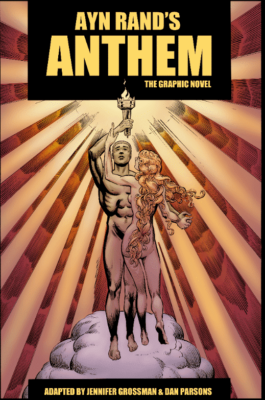
Dan: It’s like almost continuing a perpetual tribute to Alex Raymond. I didn’t mean to neglect Steve Ditko. He’s a hard guy, I don’t know if you know that. He’s a recluse or was, until he died last week or whatever it was. I can say I do have a small connection to Ditko in that. On my second ink war world back in 2015, I won my second ink well for the Star Wars stuff, and he also won the hall of fame award, so that’s a small connection to him.
Bill: Thank you very much Dan.
Bill: Here we are with one of my heroes as an animator myself and that’s Larry Houston. Larry of course was responsible for the wonderful X-Men series of the 90s and many of the things he did have become canon since then. Larry, we welcome you to the Comic Book Historians Podcast.
Larry: Nice to be here guys, and glad you guys showed up. This is a great time to talk to all my fans and answer any questions that they have.
Bill: We’d like to know, can you give us a little background on how you got involved with the X-Men series, where you came from before that and where you went after it?
Larry: Let’s see, the long story is going to be, we tried to sell the X-Men at Marvel Productions in the mid-80s and I would include them into spider man and amazing friend shows trying to tease their network. Because back then there was only three networks; CBS, NBC, ABC.
Larry: We got them to sponsor a pilot called Pryde to the X-Men and when we did Kitty Pryde and Colossus and the whole nine yards. We got the Japanese to do a really good production, we got really good characters, actors to do characters and it didn’t sell. We were really disappointed, but what happened was my boss at Marvel Productions was Stan Lee and Margaret Lash. Fast forward about six years Margaret became the head of Fox Kids. Then when she became the head, she could green light it on her own and so she gave me a call, and Will Meugniot and Eric and we said, “Let’s do the X-Men show,” and that’s how we got it on the air. Margaret Lash was the real reason it got on the air. A lot of people above her didn’t believe in the show but they let her green light the show. A lot of people didn’t have faith that it was going to succeed. You got to remember back then the internet, there was no internet. There’s no likes, these likes, none of that stuff so we had to fly by the seat of our pants and create a show that a fan boy would want to see.
Larry: But we blended it with being a fan, but also being a professional because I had been directing cartoon shows for about 12 years before I got the chance to do the X-Men. I was able to blend both of those disciplines together and do a show that I thought, “This is a show if I was a kid, I would have want to see it,” and so that’s what I did. My philosophy in doing the X-Men, is that you have to adapt when you take on from a book to a movie or a book to a TV. But my philosophy is that you only change things if you have to. Don’t change things because you can.
Larry: I would bring in my comic book collections and put it on the Xerox machine so we can make sure we got all the costumes correct. Because I was a geek and I used to read all the stuff from that 60s all the way up forward, I knew all the relationships. Who was the brother, the sister, who hated this person, who loved that person, and all that stuff. I had all this useless trivia in my head so that when the shows were being written, I would hand out the scripts, the storyboards. I knew what would work, what didn’t work, and I could tell the artists do this, don’t do that. Blow this up, make more emphasis on this, less emphasis on that. I was able to creatively guide the show and course correct as needed to make sure the show followed the comic books as closely as possible. That’s what I did.
Alex: One of my favorite episodes Larry, you might remember this one. It was when Storm and Wolverine were in an alternate dimension, or a different timeline. They were in love, but to restore the timeline they had to sacrifice their love. I’m not kidding. I was a teenager. I actually cried a little bit at the end of that episode. I’m not kidding. But one thing I want to ask you is why do you think Pryde of the X-Men didn’t get green lit? Because I loved that as a kid.
Larry: Myself, Will Meugniot and Rick Colbert, we were all puzzled. We put our best foot forward. We thought we had put together a show that met everybody’s what they wanted at the time. We tried to make it as accurate as we could of Marvel show. It was a mystery to us. I think at the time it just didn’t click with the upper management and it didn’t click with a toy company, which actually was funding the pilot. It just didn’t hit, and it wasn’t until we got onto Fox.
Larry: One of the things I like to talk about, like to remind people is that when we were doing the X-Men, we wanted to make sure we had an excellent show. We were getting a lot of crap from overseas and so we talked to Margaret Loesch, who was the head of Fox and she got on their butts and said, “Look, you guys are going to do a good job.” The show actually should have come out in September, but because we required them to do good work, it didn’t come till January.
Larry: Guess what, by January, all of the other shows were in rerun. We were the only new show so the show had a really good chance to be sampled by a lot of kids and it took off from that point forward.
Alex: Yeah, that’s awesome.
Larry: It really worked out. It wasn’t by design, it was by accident, but all the stars aligned at the right time to make.
Bill: What I loved about it I have to say is, you kept the soap opera-ness of Marvel Comics and the fact that you made sure you had the relationships, you had the inks, you had all of the drive in the TV show. That was part of your plan also, wasn’t it? That’s why it was such a serialized phenomenon, because you did follow some pretty intricate and long term storylines. That was new for animation 20 years ago, wasn’t it?
Larry: Yes, it was and a lot of that you have to put at the footsteps of Eric and Julia Lee Wall, which is the guys who are next to me. One of the things we all wanted to do was, don’t write down to kids. Write up to kids in terms of levels of sophistication. Because in the beginning when they see it, they’ll see the flash, they’ll see the explosions. But on later viewings, they’ll catch the subtext of the adult relationships going on.
Larry: There’s more enjoyment when they see it again, because they’re seeing something they didn’t see before. That’s what we wanted to do, is always write up to kids, don’t write down. Don’t make it silly and stupid.
Bill: What I also wanted to talk to you about is, it still plays today. It’s still is just as good as it was 20 years ago. I think that’s a testament to your wonderful direction and the fact that you had this vision, epic vision in my terms, and I think that you created something that is still to this day, something that’s not dated. It really tells the Marvel stories the way they should be.
Bill: Honestly, it’s a testament to you as a fan and as someone who made sure that you were quality oriented, you wanted to bring it to the kids and not give them baby art or baby storyline.
Larry: We did not want to write down to the audience. We wanted to make sure that the stories were accurate as we could like Days of Future Past. Because it was Saturday morning, you really couldn’t kill people. But we adapted the stories as best we could, to try and evoke the same feeling without showing what we couldn’t show on Saturday morning. We tried to make the story sophisticated and like I said, we only change things if we have to. If we didn’t have to, we just follow the books.
Larry: That was my philosophy and it was Eric’s philosophy and that’s how we got everything on the air. We’re really proud that kids responded as well they did, because we had no idea anybody liked what we did after the first season. For me, my personal favorite was the last episode of the first season because I figured that was my last shot and so I wanted to go out with a bang. I’d had tons of sentinels, I added stuff in that wasn’t in the script, I moved stuff around, dialogue that might have been in the middle of the show I moved it to the end of the show.
Larry: Like when Magneto helps Xavier, that wasn’t in the script. I added that. I wanted to show that bonding between these two frenemies together and that’s where I established that. Because that dialogue where he says they talk to each other, that was actually in the middle of the show and I said, “No, no, put it over here.”
Bill: The wonderful thing about that is that from what you’re saying, I can now put it together in my mind. But that was a springboard to the rest of the series, wasn’t it? Because you poured so much into that Sentinel last episode of the first season, that then you had a great direction to go from there and you had the strength of everyone behind you because it was a hit.
Larry: The very last episode of the first season, the last scenes were of them on a picnic. They’re talking about getting married and we’re going to have kids and it ends on them saying, “We don’t know what the future holds,” and it goes out on a sunset. That was it. But then when you got the pickup, they moved stuff around and added sinister as overlay because suddenly he says, “You got another 13,” and so in post-production we made up that quick overlay to try and show that something else is coming. Foreboding. But that 13th episode was my favorite out of not all of them, but it’s up there.
Bill: What are you doing now, Larry?
Larry: What I’m doing now is that I retired last year, and I am doing conventions like here at San Diego Comic Con, and other shows. I’m trying to get booked to go to different places around the country. I’m selling autographed copies of the X-Men, and back before I got into animation, I used to publish my own comic book for my own pleasure called The Enforcers. It was a black and white thing I did. It was fun, my own version of superheroes.
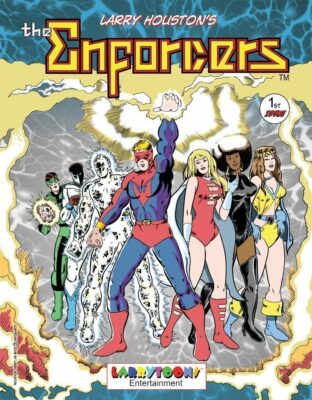
Larry: What I’ve done now, I have a color copy. It’s like a 90-page graphic novel. I literally got it from the printer just barely got it here to the convention, and I’m going to try and sell it here. I’m also going to have a place where you can buy it online so you can get copies online and eventually probably get a digital copy. But you can buy the hardcopy. It’s going to be at Indy Planets but I haven’t set up all the protocols yet. But that’ll be where you can get it from.
Bill: Fantastic. Well, we want to thank you so much for talking to us and man, we hope you have a great Con and we’ll be back to talk to you next year. Thank you so much Larry Houston.
Bill Field: I’m here talking to one of my favorite DC artists, the wonderful Chris Burnham. You probably know his work from Batman Incorporated among other things and Chris, how are you doing?
Chris: I’m doing great. Having a good time so far.
Bill: Fantastic. For the folks at home, I was wondering if you could possibly give a quick rundown of your history as a comic artist.
Chris: All right Geez. I started out doing work for Moonstone actually. They’re a small horror publisher in Chicago. I did a couple issues of Moonstone monsters and a Kolchak the Night Stalker comic and then a little graphic novel called Boston Blackie inside out. That’s got to be 15 years ago or something. Then I started working at Image. I did a couple issues of Elephant Men, a graphic novel with Joe Casey called Nixon’s pals which is about a parole officer for super villains and it’s awesome.
Chris: You can buy it on Amazon right now. Go get it, it’s rad. Then we did a book called Officer Down, which was a small critical hit that started getting me work at DC.
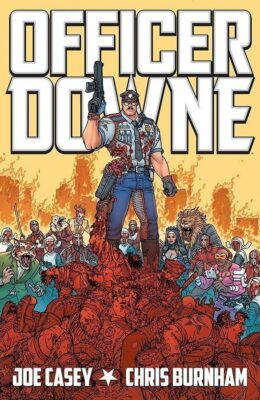
I did a Batman Incorporated with Grant Morrison for three years, and then we did a book at Image called Nameless which is a super weird, super gross sci-fi horror comic. You should get that too. Now, Robert Kirkman and I are working on a book called Die, Die, Die. The first issue just came out last week. It is very funny, very violent. It’s kind of a Quentin Tarantino movie without the feet. It’s awesome.
Bill: Fantastic, and so who are your go to’s for the people that you looked up to and maybe inspired you to become an artist?
Chris: Growing up John Buscema was my shining light. How to draw comics the Marvel way is I still think the best book on how to draw comi cs at all. When I got a little bit older Jack Kirby became a favorite of mine. Walt Simonson, Erik Larsen. The Fist of the North Star guy was a big influence on me for panel to panel action. I got my hands on a fair amount of un-translated Japanese editions of Fist of the North Star, Hokuto no Ken, and so being able to just look at that stuff with … I couldn’t read it if I tried.
Chris: Just being able to follow the panel to panel action. I really learned a lot about visual storytelling from doing that. There’s a million guys, Moebius and Frank Riley and Jeff Darrow, those are probably the more obvious surface level influences on my style at this point. There’s something to learn and copy from just about everyone.
Bill: Of course. Now, what I’m curious about is, what are some of your Con moments with some of these influencers? Now that you’re a pro yourself, have you met any of these people and what were your expectations and how’d you feel about meeting them?
Chris: Most of them were pretty nice. Frank Riley is a very nice guy. He was just randomly walking down the aisle and I said, “Hey, I’m Chris Burnham. I’m sorry for ripping off your style,” and he was like, “Oh, it’s fine. I’m ripping off Moebius and Darrow. It’s all the same thing.” I was like, “Okay, that’s good. That’s good that you’re not annoyed.” Yeah, most people are nice. I’m a bit of a, I don’t know what the word is. I’m a little socially awkward like most artists are so I’ve found a couple of real awkward bad run-ins with some guys. Jeff Darrow and I are always getting in dumb little fights and then making up. We’ll grate on each other and then make up again the next year. That’s happened a couple of times over the last 10 years. We’re in a friendly phase right now which is nice.
Bill: Except for the project you already mentioned, what’s on your horizon? Where do you want to go with your talents? What do you want to do in the future?
Chris: Oh, man. I don’t know. I think just more of the same at this point. Whatever the next fun idea is. We’re rolling on die, die, die for a while. It’s pretty fun. Lots and lots of goods and nonsense to draw. Fun action and character bits. Lots of subplots which I like. For the moment I’m having a great time with this. Who knows?
Chris: I don’t have any big … it’s not like I’m dying to draw the Fantastic Four or anything. I don’t have a big dream project other than whatever idle fancy strikes me next. For the moment die, die, die is awesome and I’m focused on that.
Bill: Working with guys like Grant Morrison and Robert Kirkman, do they bring you pretty detailed scripts and then when you visualize them … tell us a little bit about that process.
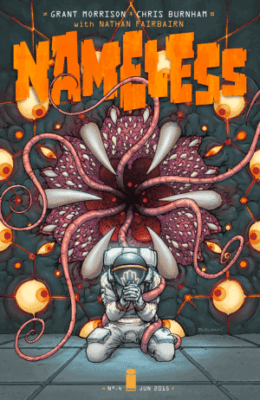
Chris: Most of the time they’re not too, too detailed. They trust the artist to execute on our own personal style. Unless it’s a very specific little bit of business, for the most part the descriptions are fairly bare bones. I would say that the main difference between their two styles is at the beginning of each issue and then maybe at the beginning of a particular set piece, Grant will take a page to say, “Here’s what we’re going for thematically. Here’s the weird movies and novels and comics’, comics’, Jesus. That we’re referencing. Here’s what to pull from for this sequence.”
Chris: With Kirkman it’s just, “Here’s the description just draw it.” They’re going for different things. Grant’s got greater thematic concerns at play when I think Kirkman, we’re just trying to tell a fun, quick, violent story. But as far as like panel to panel for the most part, they just say what happens in it and then I draw it.
Bill: Chris Burnham, we want to thank you for taking time out of your busy schedule here at the Con, because it’s nuts here. I just have to say artist alley is really on fire and so are you Chris Burnham. Thanks so much for being on the Comic Book Historian podcast.
Chris: Hey, my pleasure. Thanks a lot guys.
Bill: we’re going to go out on a limb now folks with Ron Lim. We’re going to ask him, was Norrin Rad? Was Thanos really a happy guy? We’re going to find out right now. Ron, how the heck are you?
Ronald: I’m doing great. How are you guys doing?
Bill: Fantastic. Hey Ron, can you give everybody a brief history of your professional work starting with maybe EX-mutants?
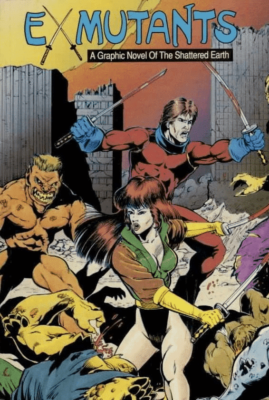
Ronald:E X-mutants was probably my first published work. I think I did Badger for first comics. What did I do after that? Then I did Psi-Force e for Marvel and I got Surfer after that. That was my big leap from the Psi-Force to Surfer.
Bill: How many surfer issues have you done to date? Do you know?
Ronald: I don’t know the exact number but I worked for almost six years on the title. I think from 15 to 92. But the latter half I missed a lot. It’s just for the Infinity stuff. I was busy with Infinity, Gauntlet war and crusade.
Bill: Fantastic. How about your influences? I’m curious who are some of the go to’s for you as far as following their art when you are achieving your own style?
Ronald: Jim Starlin of course, one of my favorites. George Perez of course, and John Byrne. Those are my three big artists I follow the most. Anything they drew, I would buy. Yeah.

Bill: Now as a pro I’m curious of your many Con experiences. Who are some of the heroes you’ve had some of the funnest meetings with and people that you really admire?
Ronald: Oh, you mean the ones I’ve met? Well, Jim Starlin I worked with him for several years. I don’t see him that often. But when we hang out, it’s awesome. He’s a great guy, so Jim. Simonson was fantastic to me. I only met him once and it was great. He was super nice. Gosh, I don’t know, there’s so many people. Yeah. I don’t know. My mind’s going blank.
Alex: When you did your first work with Jim Starlin and you had read his stuff in the 70s when it came out, was it like, well, I get to work with one of my heroes?
Ronald: Oh yeah, because I was working with Steve, which was great on Surfer. Then when Jim took over I was super excited because now I love Jim’s stuff and then they said we’ll do Banners with them. I was like, “What the heck,” so yeah. I almost couldn’t figure out what I was going to do because I was so nervous. Working with Jim, bringing back Thanos. I didn’t know it was going into the fancy stuff but it was pretty amazing. Yeah, I was happy.
Bill: I’m curious of the differences between the two writer’s style and what they gave you. Englehart versus Starlin?
Ronald: Englehart works more on a Marvel style. I think plot style if I recall correctly, I’ve been a while. Then Jim works full script style. That’s a little bit different. But other than that Jim’s stuff is tied more to his characters in the past whereas Englehart comic was more … he created his own universe kind of thing. The characters, but he created these other characters like Clumsy Foul Up and these characters that weren’t in the other stories.
Bill: Where do you go from now? What are you working on currently and where do you see yourself going in the future with the medium?
Ronald: Still working for Marvel so I keep me busy doing that stuff. I’m doing a ton of variant covers right now. I’m doing a spider man all-ages book for them right now. Right now I’m doing new stuff for Venom so that’s my latest stuff.
Alex: As an artist who knows every inch of Thanos’ body, how did you feel about the rendition of Fantasy and the Infinity War movie?
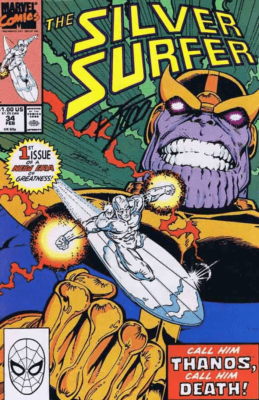
Ronald: Oh, I loved it. I was hoping that he’d be good, but I wasn’t quite sure how he’d turn out, so when I saw the movie it blew me away. I loved it. They captured Thanos perfectly I thought.
Bill: Josh Brolin got the attitude right?
Ronald: Oh yeah. Up until this movie, we only saw glimpses of it, right. I couldn’t really tell how he’d play them but after seeing the movie, yeah, he’s a perfect. I was stunned, I was like, “Wow, they pulled it off.”
Bill: Just amazing stuff, yeah. I think you had a lot to do with that because of the legacy that you’ve left with the artwork. Does that make you proud when you see the movies now?
Ronald: Oh, yeah, for sure. That they adapted it in any of our work it’s just really flattering and it’s amazing to see on the big screen. Yeah, I loved it. I was tears of joy. Yeah, it was great. It was great.
Bill: Alex, do you have anything else you’d like to add?
Alex: I just want to say that one of my first stories as a kid was the Evolutionary War stuff and I loved it. I bought a page from you a year ago and I look at it now and I’m thinking, I remember the innocence of discovering the universe with your art. I appreciate it.
Ronald: Yeah.
Bill: Ron, as an artist myself, I’ve looked up to you for years and now meeting you it’s just fantastic. I want to thank you so much for giving us a few minutes of your time today for the Comic Book Historians podcast.
Ronald: My pleasure. It was a blast.
© 2020 Comic Book Historians
